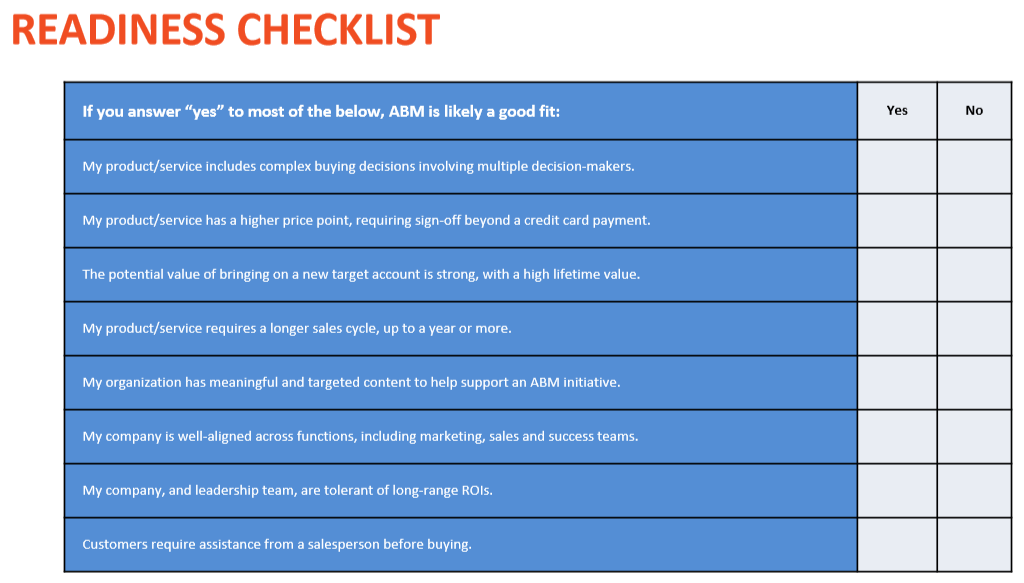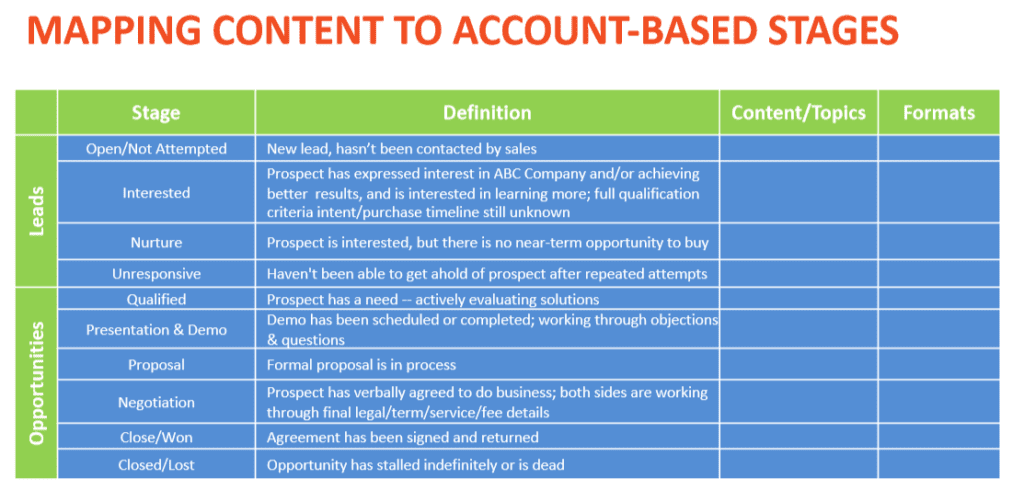Any B2B marketer worth their salt understands the power of account-based marketing (ABM). It’s been widely adopted due to its proven success rate throughout the B2B industry. But there’s a movement taking place, as marketers jump on the ABM train due to the expected ROI and pace of excitement. But, any good ABM program has to start with a strategic lens – and end with one. Lately, this seems to be lacking as sales and marketing silo their goals rather than unify them.
A full 87 percent of B2B marketers now agree that ABM delivers higher ROI compared to other marketing efforts. And 92 percent consider ABM “extremely” or “very” important to their marketing efforts.
What is Account-Based (Strategy) Marketing
Account-based marketing is a strategic B2B approach that is concentrated on a set of clearly defined target accounts. These accounts are identified as the most important prospects for a business. Sales leads the conversation – but marketing puts the magic in the program.
So, how does your brand get from strategy to implementation, action and results? Follow the step-by step-guide below so that your marketing team can achieve results with a post-sale, FULL-cycle ABM strategy. You’ll learn what to do even after you’ve closed the deal on your target ABM accounts. As a result, your brand will acquire and retain your ideal customer base, while achieving optimum revenue goals.
Not sure if ABM is right for your B2B company? Before continuing with this step-by-step program, we recommend completing the below checklist:

Step 1: Focusing on the Right Targets
The Rs to Success: Research, ROI and Return on Relationship.
Dare to be specific. Don’t think of hypothetical personas. Do your due diligence. Drill down to get to know the target companies, even the exact individuals who make the purchasing decisions. You can identify target accounts with fit, using predictive marketing (look-a-like and propensity models to identify accounts); intent, looking at in-market activity across the web by topic; and behaviors, by tracking activity such as understanding who is coming to your site or engaging with your brand.
As you develop your ABM strategy, assess what your ideal customer profile looks like and don’t waste effort on prospective accounts that will not give you the biggest bang for your buck.
Additionally, focus on the longevity of your relationship of that targeted account and those that will eventually become advocates for your brand. Building long-term relationships can result in a strong ‘Voice of the Customer’ program, an increase in brand advocates, strong referrals and an overall high RoR (Return on Relationship).
Step 2: Integrating Your Teams
Align. Communicate. Collaborate.
Building that relationship for the long run “takes a village.” Align each of your departments – sales, marketing, customer relations and/or support.
Sales + Marketing + Customer Relations = Brand Advocates
Set your teams up for success by identifying the right roles and resources to get you started.
From a tactical, day-to-day standpoint, your team should have someone that’s going to review and segment historical data; identify customer profiles; review and update account data on a regular basis; and implement CRM tools, updates and processes.
From a more high-level standpoint your team needs someone to strategize, run point between sales and marketing; educate teams on customer awareness, engagement and acceleration; CX; best practices and lessons learned.
However, the most meaningful role – and often the most forgotten – is the one that maintains, monitors and reports on the ABM accounts post-sale. How satisfied is that account? Are they continuing to be nurtured? Given the right content at the right time? Have they been adopting new services or products? This role and resource for your ABM team will be critical to the overall success rate and longevity of this program.
Carrying over the enthusiasm and commitment of the sales cycle into the hard work of managing the client account and providing an exceptional customer experience ignites the power of account-based marketing well beyond the sale.
Find common goals, strategy and metrics across your organization. Making sure everyone is on the same page (and has the same expectations) is critical when taking next steps towards a named account strategy. Step 6 will dig in even further on how to align and define these key metrics and goals between each department. For now, your integrated teams should be focusing on roles and resources needed within your organization, the strategy, how to communicate with each other and at what customer “trigger points” are you passing off in terms of CX, relationship-building and nurturing. Sales pass to marketing, marketing to customer success, back to sales for the upsell (think: land and expand). Any lack of communication in this daisy-chain will throw ABM efforts out the window.
Not sure if your team has the right skill sets available for ABM success? Consider tapping an integrated agency to backfill your in-house efforts. Public relations, content marketing, social media and influencer marketing all play a role in ABM content strategy. If you don’t have all the pieces in place, don’t delay bringing the right talent to the table through outsourcing.
Step 3: Implement an ABM Content Strategy
Personalize. Map Content Pre, During and Post Sales.
The power of ABM is not only targeting those relevant accounts, but also building highly personalized messaging. Your content and engagement strategies are critical. By appealing to the emotional needs of your audience, you can develop highly tailored, actionable and authentic content. Then map that content to account-based stages.
A successful strategy requires an integrated approach. Owned, earned, shared and paid media all work together and support each other – driving one consistent message while effectively aligning resources that drive action and outcomes for your ABM efforts. It’s important to understand the power of integration. People will drive that connection and personalization will fuel the engagements.
Consider the customer journey through the ABM process. A pre-sales social media post targeted a particular organization. A guest blog from a prospect during the pre-sales cycle. A request for a case study from a client after a successful campaign. Use these touchpoints to build relationships.
Pre-Sales ABM Content
47 percent of buyers viewed 3-5 pieces of content before engaging with a sales rep (Demand Gen Report).
This is your brand’s time to shine. You’re looking to turn the data and information that you’ve previously gathered into helpful and (internally) shareworthy content for that prospect. Your targeted accounts won’t be able to find this type of information elsewhere – setting your brand apart from its competitors. This kind of thoughtful personalization might take time, but the results will take you into the sales cycle of this journey.
During-Sales ABM Content
Now that you’ve made the sale, there’s no time to waste when it comes to building that customer relationship. First impressions will make or break your brand’s reputation and customer experience. On the flipside, don’t overload your new accounts with content. Assess, prioritize and acknowledge their pain points as a first step. This should be information that’s fresh and documented from the sales team. Marketing can leverage that to build out helpful content that guides them towards an easy transition into using your product or service. If you’re not sure what kind of content would be most valuable for your new customers – go back and do your research. Investigate what they’ve been sharing and discussing on their channels, ask questions or simply send a quick survey.
 Post-Sales ABM Content
Post-Sales ABM Content
Solid content marketing is imperative here – how do you create a detailed content program that keeps customers engaged, highlights loyalty and brings out customer voices? Foster a long-term customer relationship with a full content experience. Use case studies, customer spotlights, Q&As, and customer reviews. Continuously appeal to customer emotions and roadblocks. It’s a two-way feedback loop – ask your customers how you can improve.
Make your content easily accessible and digestible so that they’ll come back for more. Strive to be that go-to resource and thought leader for your post-sale ABM accounts.
Whether the account is a warm lead or an about-to-be-signed new account, mapping out content journeys for each will continue to move them through the sales funnel towards success.
Use the below checklist so that you can tackle each customer stage of your content mapping journey:

Step 4: Apply Complimentary Content Distribution Techniques
Touchpoints Beyond ABM.
Did you know that earning a new customer is between 5 to 25x more expensive than retaining current ones? And the average customer spends 67 percent more between months 31 and 36 with a business than they do from months 0-6? This makes any extra effort to retain your ABM acquired customers all the more important.
Build longevity by continuing to reach out using personalized, targeted touchpoints.
Include different channels of communication – social media, emails, surveys, invitations to private events, etc. Do whatever it takes to improve the customer experience, differentiate your company from the rest and keep clients from straying.
Monitor, listen and engage with your post-sale ABM customers. Celebrate their successes, engage with them on industry trends, collaborate on campaigns, speaking opportunities and the like – all while keeping their primary objectives and goals at the center of any outreach.
Focusing on the accounts you have in the pipeline is useless if you can’t keep the ones in hand happy.
Only 31 percent of marketers are personalizing campaigns and only 21 percent are focused on customer experience (PAN Communications & Holmes Report).
Step 5: Defining Success Beyond the Sale
Revenue. Retention. Reputation. Referrals.
How do you define success beyond the sale? Ask yourself the following three questions:
- Are you retaining those customers?
- Are you building brand advocates with a Voice of the Customer program?
- Have you mastered the upselling process?
Voice of the Customer
Loyal customers are 5x as likely to repurchase, 5x as likely to forgive, 4x as likely to refer, and 7x as likely to try a new offering.
Retaining and building brand advocates is the goal. Developing a Voice of the Customer (VoC) program to create great customer experiences will move you towards that goal. A VoC program should be embedded within your post-sales cycle ABM strategy and a way for you to determine the success rate of these programs as outlined below.
Your brand’s VoC program should include customers that encapsulate and align with your brand’s core values. These customers are going to be the drivers when it comes to reaching prospects under similar personas, so you’ll want them to be the best brand advocates that you have. Leverage this relationship even further by capturing the tone and preferences of your ABM accounts. It should show them that their feedback and opinions truly matter.
As you continue to build out your VoC program tied alongside your ABM strategy, don’t forget to document everything that you’ve learned. Update your personas and targets to include new communication channels, unresolved customer pain points, disrupting industry stats, lessons learned, customer quotes and testimonials. Your team should have a knowledge bank that will guide and lead your ABM efforts into future success stories.
Remember the 4 R’s for defining the success of a VoC program:
- Revenue: Land and expand.
- Retention: Making customers feel important and becoming an extension of their team.
- Reputation: Word of mouth is key here even if it doesn’t lead to a referral right away. Ask for testimonials and quotes in the interim.
- Referrals: Business connections can go a long way, especially if a previous customer has just jumped ship to another company, they’re likely to recommend your agency to that new company.
The 4 Rs should translate into a platform sales, marketing and other key stakeholders can point to for validation. This will help drive new business and revenue for your organization.
Step 6: Measuring ABM Throughout the Customer Journey
What is the coin of the realm in your business?
- New business revenue generated
- Increasing revenue per account
- Upselling existing accounts to a premium product or service
- Finding efficiencies to increase net revenue
- Superior customer experiences
Before getting started on KPIs, ensure sales and marketing teams agree on specific lead scoring and hand-off rules. ABM KPIs are different than your standard marketing metrics. Track impact and influence, time spent, and quality over quantity. Before someone spends money with you, they’ll spend time with you.
It’s about accounts, not leads. Ensure that you and your teams have the tools they need to manage and track the customer experience. Assess your martech stack and identify what you may be missing when it comes to KPIs and metrics.
Your ABM metrics should ladder up to the rest of your marketing KPIs. Track not just generic measurements but also get to true ROI (Return on Investment — or Return on Impact). Take a dual approach to your analytics. This means aligning those marketing KPIs with topline business goals. Think of measurement as a continuum, starting with your organization’s big picture revenue goals and drilling down to the granular, tactical results.
Conclusion
Success beyond the ABM sale requires bringing VoC, content and integrated teams together so that you end up with loyal, long-term happy customers. Happy customers lead to higher retention rates, a better brand image, and references; all of which fuel the bottom line, growth.
Interested in learning more? Check out the video highlights from the ABM, Demand Generation and B2B Growth Workshop at Growth Marketing Conference. This workshop video features Mark Nardone, Executive Vice President, Marketing & Business Development at PAN Communications and Scott Vaughan, CMO at Integrate.
This post originally appeared in Growth Marketing Conference on March 15, 2019.





